Singing the City: Recording the Sounds of New Orleans
Asher Kaplan looks at a recent project by Jebney Lewis, Rick Snow, and Christopher Staudinger that raises questions about authorship, collaboration, and community involvement.
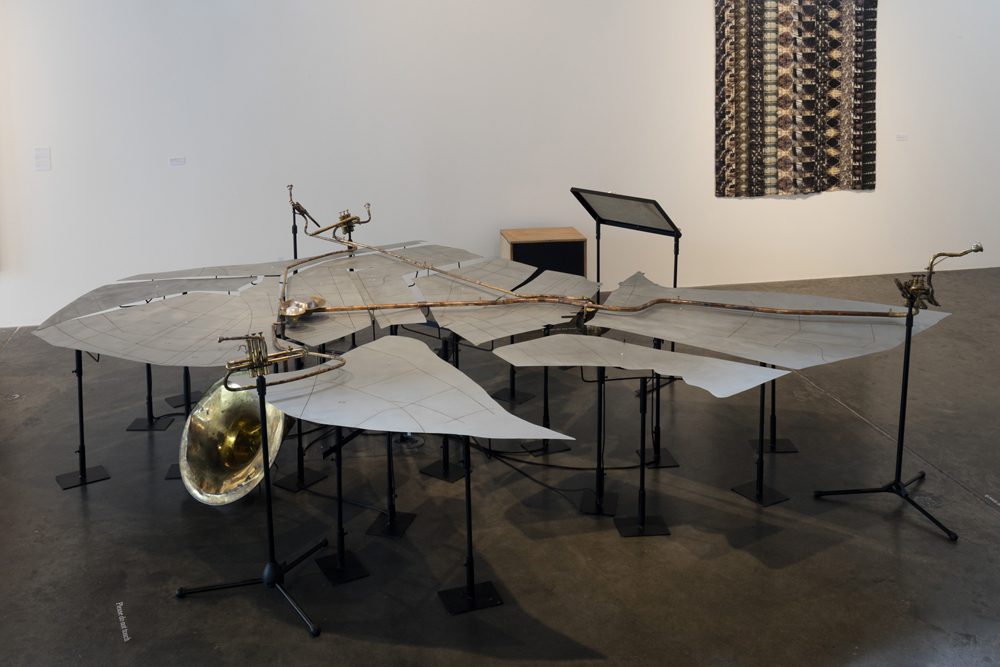
Installation view of Jebney Lewis, Rick Snow, and Christopher Staudinger’s Songs of Home Songs of Change, 2016, at the Contemporary Arts Center, New Orleans. Steel, electronics, wood, paper, brass instruments. Courtesy the artists and the Contemporary Arts Center, New Orleans. Photo by Jonathan Traviesa Studio.
Songs of Home Songs of Change is a map of New Orleans. A collaboration between artist Jebney Lewis, musician Rick Snow, writer Christopher Staudinger, and around 50 students from different high schools in New Orleans, the map represents the city—famous for its music—through the unique sound palette that fills its streets and homes. The sculpture is made out of thin sheets of metal divided into smaller plates representing the city’s 17 wards. These plates sit on stands that rise from the ground at tabletop height. Each plate is attached to a magnet from an audio speaker, which transforms them into makeshift amplifiers. The map, composed of these sonified plates, “plays” field recordings that were made by the high-school students in response to the following prompt: “What are sounds that make you think of this city as ‘home,’ and what sounds can you use to tell a story about how the city is changing?” The students were then asked to write about the sounds they chose to record, which were collected in a booklet of texts that accompany the map.
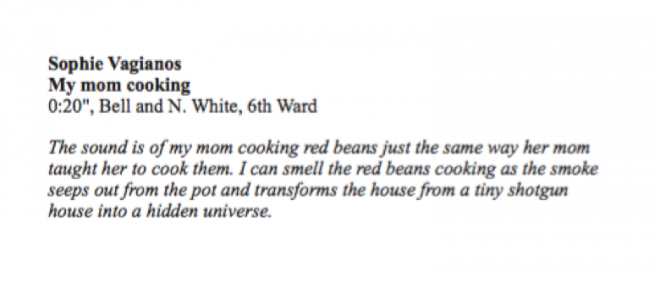
All of the following images are from a booklet that accompanies Songs of Home Songs of Change.
According to Lewis, Songs of Home was inspired by visual similarities between the curves of the freeway exchanges near the Superdome and the curved tubing of brass instruments. Hanging a few inches above the metal plates, bent and elongated brass instruments trace an outline of the city’s highway system. While the construction of the overpass in the 1960s created a massive and forbidding barrier in the middle of Tremé, pushing out much of the social and commercial activity along Claiborne Avenue, brass bands and Mardi Gras Indians continue to gather under and around the bridge. The use of brass instrument tubing to map out the freeway system points to the historic relationship between musicians and the overpass and suggests the city’s musical tradition as a form of resilience.
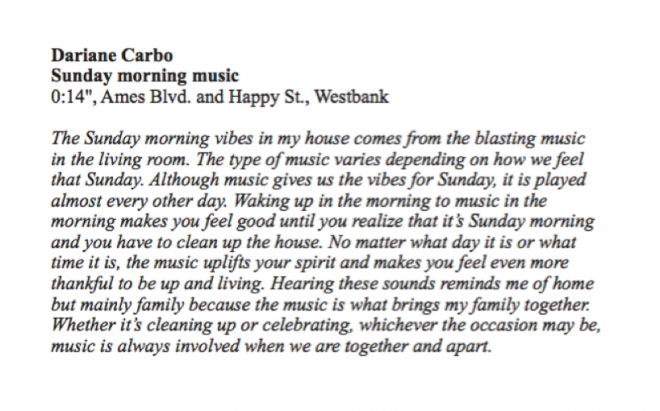
Staudinger spoke with me at length about his experience working with the students and the power of writing as a form of therapy. “Kids are not listened to ever, but they’re also really brilliant,” Staudinger said. “There are things written as part of the piece that are really important for people to read.” When I asked him about what the project might provide for the students, he mentioned a young man who had recently immigrated to the United States and could not fluently speak English. Frustrated by his inability to communicate, the student was able to relieve some pressure through his writing. The students’ collected writings are positioned like an orchestral score on a stand alongside the map, highlighting both writing and music as methods of healing.
Songs of Home was shown earlier this year at Tulane City Center (now the Small City Center) of the Tulane School of Architecture and most recently at the Contemporary Arts Center in “‘A Building with a View’: Experiments in Anarchitecture.” As a part of the first showing, students sat on a panel, spoke about their experiences, and responded to questions posed by faculty from Tulane, reversing the roles of a typical academic setting. Collaboration and interaction between students, artists, and audiences are, in a sense, the goals of the work. As Lewis put it during a conversation with me:
“I’ve found, in [my] projects...having some event or putting on a show, engaging people in a situation where they have to come together as a group to create collectively is a great motivator. It binds people. For some reason, if everyone’s meeting to pursue some kind of common project, it creates a structure that carries people through. The sculpture is just an artifact of the relationship building that the group hopefully does.”
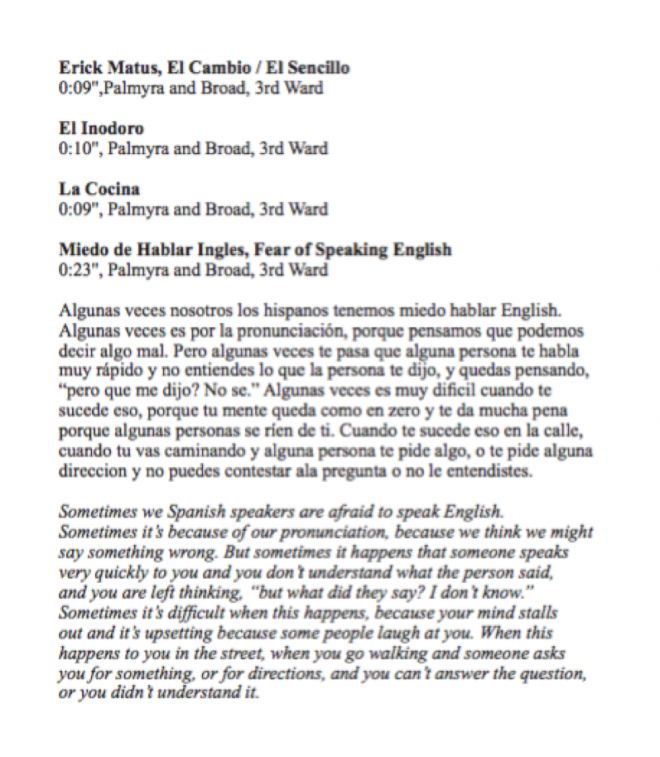
When reading, writing, and thinking about art in rapidly gentrifying American cities, it’s important to recognize the uneven power dynamics between those players in the field who are recognized by name—artists, curators, critics, institutions, funders—and the great number of administrators, custodians, guards, interns, and other, generally lower-income, workers and contributors whose labor forms an invisible arm of the culture industry. In her 2010 essay “Politics of Art: Contemporary Art and the Transition to Post-Democracy,” writer and artist Hito Steyerl says, “Even though political art manages to represent so-called local situations from all over the globe, and routinely packages injustice and destitution, the conditions of its own production and display remain pretty much unexplored.” In thinking about Songs of Home, it’s interesting to consider how different participants become more or less visible as authors when the project appears in different public spaces.
At the Contemporary Arts Center, Songs of Home Songs of Change was nominally attributed to Lewis, Snow, Staudinger, and student collaborators. The students appeared by name in the accompanying booklet, where the artists listed them each individually by first and last name, emphasizing their roles as authors of the work. Though the students generated all of the source texts and audio for the project, once the work entered into the institutional art world, which relies on a more rigid, individualized idea of authorship, the artists began to emerge as the map’s primary creators.
It’s also important to recognize that the project, which uses the stories of students who are mostly black and from low-income families as its material, was initiated by three white artists and installed in one of the city’s major art institutions. When I spoke with the artists, they were aware of mindfully negotiating empowerment and exploitation and deeply engaged in questions about the ethics of representation in their work. Both Staudinger and Lewis felt that they and the students they worked with had had a meaningful experience together. If Songs of Home found a way to wrestle with these problems in a self-critical and respectful way, the power imbalance between the artists, the students, and the institution still feels somewhat unresolved. But Songs of Home does present an opportunity for youth to emerge in the center of a discursive space within the institutional art world. It’s a work of public art that both amplifies and empowers voices from so-called “marginalized” communities, and is a reflection of some of the same dynamics that cause that marginalization.
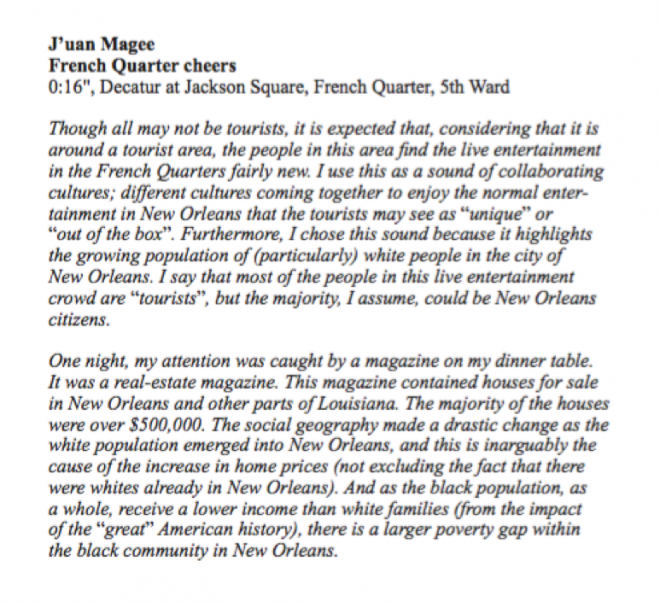
A few days after speaking with Lewis and Staudinger, with these ideas still on my mind, I headed back to the Contemporary Arts Center and followed their suggestion to sit in front of the map for a longer period of time. It emits a haunting, mechanical sound; the high-pitched screech of a braking streetcar disappears into a snippet of hip-hop, a voice speaking in Spanish, rain dripping onto metal, and prolonged periods of eerie, quiet murmuring. The map’s patterning of noise and silence gives the sense that it is itself alive, lurching between activity and sleep. After a while, the erratic sounds echoing in the gallery put me into a trance-like state. When I pushed through the Contemporary Arts Center’s heavy glass doors back onto the sidewalk I was slightly dazed, but hyper-aware of what I was hearing. Nothing seemed entirely new—cars rolling down the highway ramp onto Camp Street, the wind of a passing biker, a group of tourists, a distant siren. For a moment they all seemed to slip together with the sounds coming from the gallery, a humid, glass and metal voice.
Editor's Note
Songs of Home Songs of Change was on view August 6 – October 1, 2016, in “‘A Building with a View’: Experiments in Anarchitecture” at the Contemporary Arts Center (900 Camp Street) in New Orleans.



